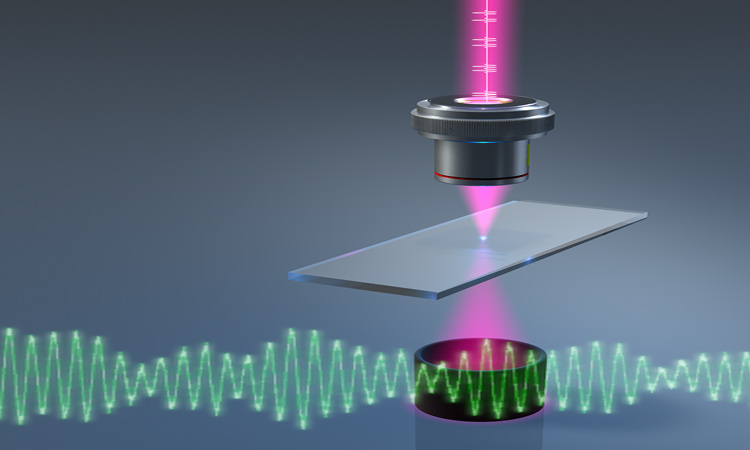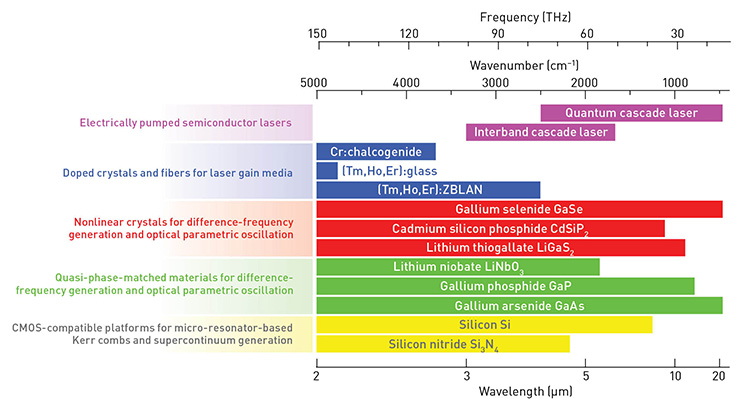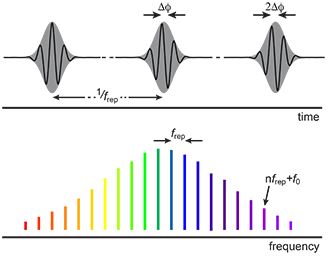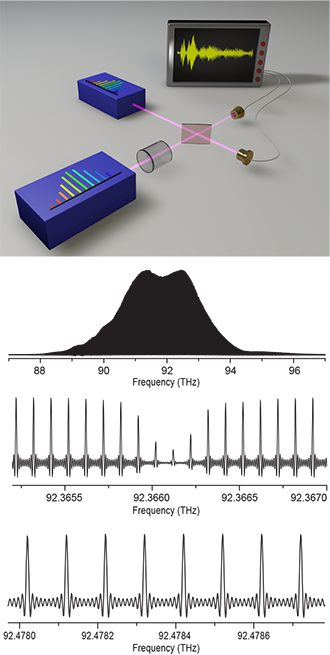 [T.W. Hänsch and N. Picqué]
[T.W. Hänsch and N. Picqué]
The past decade has seen significant progress in the development of novel mid-infrared (mid-IR) coherent light sources spanning a broad spectral bandwidth, and of new spectrometric techniques to make the most of them. Researchers now harness such light sources—based on mode-locked lasers and nonlinear frequency conversion, on frequency comb generators, on supercontinua and on chip-scale devices such as microresonators—in schemes such as dual-comb spectroscopy, Michelson-based Fourier transform spectroscopy or high-resolution crossed-dispersion spectrometry.
Mid-IR spectroscopic sensing has a long history, with decades of development, implementation and continual improvement of powerful instruments.
Spectroscopy with these devices is still at an early stage. Yet these techniques hold out the promise of improved molecular sensing for environmental science, analytical chemistry and biomedicine. Here, drawing mostly on selected examples from our own research, we illustrate the field’s progress, and we discuss new opportunities and future prospects, especially for on-chip spectrometers that could herald a generation of compact, flexible and rapid sensing devices.
Molecular fingerprinting
The mid-IR spectral region, from 2 to 20 µm, is called the molecular-fingerprint region, because most molecules have intense fundamental vibrational bands there. The IR spectrum of a given molecule thus provides a unique way to non-intrusively identify and quantify that molecule in any phase of matter. The strength of transitions in this spectral band may be more than a thousand-fold stronger than in the near-IR telecom region, enhancing the detection sensitivity by a similar proportion. The mid-IR region also has several windows of transparency in Earth’s atmosphere (for example, 8–14 µm and 3–5 µm) that are important for applications to environmental gas sensing. And, combined with microscopy and imaging techniques, mid-IR spectroscopy offers label-free chemical contrast in biosensing of cells and tissues.
 Broadband mid-infrared coherent sources
Broadband mid-infrared coherent sources
Mid-IR spectroscopic sensing has a long history, with decades of development, implementation and continual improvement of powerful instruments. In the laboratory and in industry, mid-IR sensors are routinely used in analytical chemistry and biomedicine. Fourier transform spectrometers—whether ground-based or onboard satellites, aircrafts or atmospheric balloons—have provided broad survey spectra leading to new insights regarding Earth’s atmosphere and climate, and for a host of other meteorological, industrial and remote-sensing applications.
Sensors relying on tunable semiconductor lasers provide compact, sensitive devices that can interrogate, quickly and with precise spatial localization or over integrated long columns, small spectral spans typically of one transition in a gas molecule.
These increasingly powerful instruments, however, come with ever more complex scientific challenges. One example lies in the satellite missions aimed at quantifying regional sources and sinks of carbon dioxide, to help constrain the rapidly changing anthropogenic emissions that affect climate change. These missions, including the Orbiting Carbon Observatory of the U.S. National Aeronautics and Space Administration, GOSAT of the Japanese Aerospace Exploration Agency, or the Microcarb mission of France’s Centre National d’Études Spatiales, require reference data such as highly accurate absorption cross-sections of carbon dioxide in the conditions in which it exists in the Earth’s atmosphere. Meeting the expected accuracy requires laboratory measurements of molecular line intensities and line profiles at the limit of what is now possible.
Another example of scientific challenges comes from biomedical applications. Vibrational spectroscopy provides a label-free technique for determining time-resolved molecular reaction mechanisms—a potential boon to biomedical study. Yet single-molecule detection in live-cell imaging by spectro-microscopy still faces overwhelming hurdles in achieving the requisite sensitivity at high data acquisition speeds. Many research groups are now targeting the goal of visualizing single proteins and the processes involving them in complex dynamic systems, in real time and at up to nanometer spatial resolutions.

Frequency combs
A frequency comb is a spectrum of evenly spaced, narrow laser lines, generally created using a mode-locked laser. In the time domain (upper trace), a train of ultrashort pulses is emitted by the laser, with a repetition frequency determined by the inverse round trip-time of the pulse in the resonator. The dispersion in the oscillator causes a phase shift between the carrier and the envelope of the electric field, with pulse-to-pulse increases in offset of Δφ. In the frequency domain (lower trace), this results in a spectrum of equidistant frequency components that obey the relation fn = nfrep + f0, in which n is a large integer and the carrier-envelope offset frequency f0 is given by Δφfrep/2π.
Originally invented for frequency metrology, in which they are used as highly accurate optical frequency rulers, frequency combs have subsequently found new applications including spectroscopy and sensing over broad spectral bandwidths.
The new sensors
New techniques are arising to meet these and other challenges—driven in particular by progress in coherent light sources. Lasers that directly emit over a broad mid-IR spectral span, while now scarce, are under active development, with amplifying media such as rare-earth-doped fibers or quantum cascade semiconductors.
Usually, light from a near-IR or visible laser is converted into the mid-IR using nonlinear frequency conversion approaches such as difference-frequency generation or optical parametric oscillation. New crystals, such as orientation-patterned gallium phosphide, have recently enabled substantial progress in high conversion efficiency and broad phase-matching bandwidth, and in high-power near-IR laser systems. Mid-IR sources with broad spans and high average powers, exceeding 100 mW in some cases, are now reported.
The spectrum of near-IR or mid-IR pulsed radiation may also be conveniently broadened in nonlinear waveguides, such as silicon nanowires on chip. To these quickly advancing techniques, frequency comb technology adds further advantages. Such combs provide an array of phase-coherent laser lines that can directly calibrate the spectra’s frequency scales. And, from the research of many different groups worldwide, a new class of table-top, high-brightness laser systems has emerged, with spectral spans as broad as several octaves.
These new light sources open up novel opportunities for spectroscopy. Broadband coherent sources can straightforwardly improve existing spectrometers such as scanning Michelson-based Fourier transform interferometers or grating spectrographs such as crossed dispersers. For the same signal-to-noise ratio and resolution, the measurement time of the spectra may be improved by several orders of magnitude simply by replacing the usual thermal light source by a broadband, high-brightness coherent source.
High-average-power laser systems enable the use of high-finesse resonators or multi-pass cells for enhancing the sensitivity to weak absorptions of species such as trace gases. The high average power also facilitates the use of mid-IR cameras of low sensitivity, analyzing the light at the output of a crossed disperser. The laser beams are also suited to, and even advantageous for, a large variety of sample settings. For example, they can conveniently interrogate outdoor open-air paths with length on the scale of a few kilometers, and can eliminate the main source of out-of-focus photon background in microscopy.
Broadband coherent light sources also stimulate the exploration of new spectrometric techniques. For example, two frequency comb generators of slightly different pulse repetition frequencies enable Fourier transform spectroscopy without moving parts through a dual-comb interferometer. Dual-comb spectroscopy is emerging as a powerful tool for accurate, fast and sensitive broadband spectroscopy of molecules. Like common Fourier-transform spectroscopy, it needs only a single fast photodetector—but it is free from the limitations on recording speed and resolving power imposed by mechanically moving parts of a conventional interferometer. (See also “Dual-Comb Spectroscopy,” Optics & Photonics News, January 2017.)

Spectroscopy with broadband coherent sources. A broadband coherent light source (here a frequency comb) interrogates a sample—either in an enclosure or in the open air, and either in the gas phase or the condensed phase. The sample’s response is measured using the light transmitted through the sample or generated through the emission by the sample during decay to lower energy states. A spectrometer measures the output spectrum.
A mid-IR dual-comb example
Dual-comb spectroscopy in the mid-IR region has faced several challenges. Beyond the obvious but complex requirement of suitable frequency comb synthesizers in that spectral range, the two comb sources also must maintain mutual optical phase coherence during data acquisition. Any relative instability makes it impossible to average the interferograms in the detector signal over time—which is necessary to improve the signal-to-noise ratio and thereby to obtain usable spectra even under light-starved conditions.
In practice, the goal of mutual coherence is difficult to reach, especially in the mid-IR region where the laser systems are still often based on nonlinear frequency conversion and are thus more complex. Nevertheless, several groups have previously reported experimental coherence times on the order of 1 second with elaborate laser stabilization schemes.
 [Z. Chen et al., Proc. Natl. Acad. Sci. USA 116, 3454 (2019)]
[Z. Chen et al., Proc. Natl. Acad. Sci. USA 116, 3454 (2019)]
A dual-comb mid-IR interferometer
In dual-comb spectroscopy, a frequency comb interrogates the sample and interferes on a fast photodetector with a second comb, of slightly different repetition frequency, acting as a local oscillator. The interference pattern is recorded as a function of time; its Fourier transform reveals the spectrum. As the approach measures all of the spectral elements simultaneously on a single photodetector, it can work in virtually any spectral region, and the resulting spectra show an exceptional consistency and high quality spanning as broad a range as the emission range of the lasers.
The system shown here begins with two near-IR (telecom band) frequency combs—with repetition frequencies of 100 MHz and 100 MHz + 100 Hz, respectively—based on erbium-doped fiber femtosecond lasers. An acousto-optic feed-forward servo scheme for carrier-envelope offset frequency control establishes the combs’ relative coherence, and provides both very fast response times and long-term operation. Nonlinear difference-frequency generation produces two frequency combs of long mutual coherence times in the important mid-IR 3-µm spectral region, where hydrocarbons and oxygen- or nitrogen-containing organic compounds have strong, characteristic absorptions.
In results from one experiment, a spectrum of 82,000 comb lines, centered at 92 THz (3.2 µm), was measured within 29 minutes. The rotational–vibrational transitions of the absorbing sample—here, ethylene (C2H4) at low pressure—are satisfactorily captured by the comb lines of 100-MHz spacing. Zooming into an individual comb line shows that it has the expected line shape. The absolute frequency of each comb line, meanwhile, is known within the accuracy of an atomic clock, and the narrow linewidth renders negligible the contribution of the instrumental line shape to the observed molecular profiles. The technique is therefore very suited to precision molecular spectroscopy.
In recent work, our group has developed an experimental approach that has achieved mutual coherence times exceeding 30 minutes in the 3-µm region (see “A dual-comb mid-IR interferometer,” right). The system begins with two fiber-laser-based near-IR frequency combs, with acousto-optic feed-forward servo control to stabilize the combs and with nonlinear difference-frequency generation to produce combs of long mutual coherence times in the 3-µm mid-IR spectral region. It works without moving parts and measures mid-IR high-resolution spectra with excellent consistency over a broad span. Because of the long-lived mutual coherence, time-domain interferograms can be directly summed without corrections to them or to the spectra, simplifying data acquisition and avoiding artifacts from numerical processing.
One key advantage of such a dual-comb system lies in its calibration. The frequency scale in the system shown here is directly calibrated by an atomic clock, in contrast to approaches such as scanning Fourier transform spectroscopy with incoherent light sources, which must rely on standard lines measured by others.
Spectroscopic instruments that measure across broad spectral bandwidths, like dispersers equipped with a camera or scanning Fourier transform spectrometers, have an instrumental line shape with a width comparable in magnitude to that of the atomic or molecular transitions being interrogated. Consequently, the retrieval of line parameters requires nonlinear-least-square fitting to account for the convolution by the instrumental line shape, which reduces the precision and accuracy of the results. With phase-coherent dual-comb spectroscopy, employing self-referenced combs, the instrumental line shape is determined by the individual comb lines, and can become negligible relative to the Doppler-broadened lines of small molecules at room temperature.
Toward mid-IR on-chip sensors
Fiber laser systems, such as the one in the mid-IR lab-scale spectrometer described above, can be compact and low in electrical-power consumption, and thus, in principle, easily transportable. Recent reports, however, point to even more compact frequency comb sources that could eventually lead to chip-scale sensors. In particular, the past several years have seen significant progress toward broadband, on-chip coherent mid-IR sources and spectrometers. Fully integrated, turnkey on-chip systems harnessing broadband coherent light sources will likely require significantly further research, technology and development effort. But the first proof-of-principle demonstrations of some required components have shown intriguing potential.
As future on-chip light sources, frequency comb generators based on microresonators are attracting much interest. Chip-scale platforms involving highly nonlinear materials make it possible to realize high-quality-factor dispersion-engineered resonators on the micrometer-diameter scale. When pumped by a narrow-linewidth, continuous-wave laser, the microresonator, in which the light is tightly confined, can host parametric nonlinear processes, such as the formation of dissipative solitons and, therefore, of large-line-spacing frequency combs.
While this technique is maturing in the telecom wavelength region, the prospect of fully integrated mid-IR frequency comb generators on a chip still faces daunting challenges, especially at wavelengths longer than 5 µm. Nevertheless, the research groups of OSA Fellows Alexander Gaeta and Michal Lipson at Columbia University, USA, have successfully fabricated mode-locked Kerr frequency combs in silicon microresonators, with a span from 2.6 to 4.1 µm. Other platforms take advantage of second-order nonlinearities, such as the electro-optic combs in lithium niobate resonators developed in the telecom band by the group of OSA Fellow Marko Lončar at Harvard University, USA. It will be interesting to see whether the operation of these systems can be extended over the entire transparency range of lithium niobate (up to 5 µm).
These CMOS-compatible platforms, which include silicon nitride as well, are also powerful for nonlinear optics, such as spectral broadening of ultrashort pulses. Using highly nonlinear dispersion-engineered silicon nanophotonic waveguides on a silicon-on-insulator chip, for example, phase-coherent octave-spanning comb spectra can be produced in the 3.3-to-1.5-µm range, as our team demonstrated in a collaboration with the group of OSA Fellow Roel Baets at Ghent University, Belgium.
Other noteworthy comb sources are quantum cascade lasers and interband cascade lasers. These compact semiconductor sources, pioneered by the research group of OSA Fellow Jérôme Faist at ETH Zurich, Switzerland, are electrically pumped and emit directly across the mid-IR and THz regions, from 2 µm to 250 µm. Their average power may be as high as 1 W but, owing to design challenges, their span is still rather narrow, typically 1 THz, corresponding to a couple of hundred comb lines. As these devices can also operate as fast detectors, they hold promise for on-chip spectrometers.
Condensed-matter sensing
A unique feature of on-chip comb sources is their large line spacing (greater than 10 GHz), which can hardly be achieved with mode-locked laser systems that used doped fibers or crystals as gain media. The large spacing opens up new opportunities for rapid spectroscopy in condensed matter.
With dual-comb spectroscopy, the optical delay between pairs of pulses is automatically and repetitively scanned. Its excursion is given by the line spacing of the comb, 1/frep, which leads to spectral resolution equal to frep. Therefore, using a dual-comb system with a line spacing of the same order of magnitude as the desired spectral resolution avoids scanning unnecessarily large optical delays, which results in a far-from-optimal use of photons and experimental time.
In the gas phase, the rotational transitions in the fundamental vibrational bands of small molecules are generally narrower than 1 GHz at low pressure (Doppler broadening) and lower than 10 GHz at atmospheric pressure (collisional broadening). In the condensed phase, however, the vibrational bands are often broader than 100 GHz. Chip-scale frequency combs are therefore ideally suited for spectroscopy in the condensed phase. For a span of 150 THz, a dual-comb system with frep = 100 GHz can record an interferogram in as little as 30 nanoseconds.
This could lead to new perspectives in the molecular-fingerprint region for time-resolved spectroscopy of single events that might be important in chemistry and biology. The prospect is challenging, though, as getting a good signal-to-noise ratio within such short measurement times appears technically demanding. Recently, the first proof-of-principle demonstration of dual-comb spectroscopy in the 3-µm region with two silicon-microresonator-based combs at 127-GHz line spacing, pumped by the same continuous-wave laser, showed the possibility of measuring spectra with some 25 well-resolved lines within 2 microseconds.
Chip-scale combs are not inappropriate for gas-phase spectroscopy, either, as several spectra may be sequentially recorded with a stepped carrier-envelope offset frequency, to be interleaved a posteriori. With improvements to the fast and accurate control of the positions of the comb lines, powerful tools for gas-phase spectroscopy, suited to experimental conditions where the sample does not vary during the recording time of a series of interleaved spectra, could become available.
Expanding prospects
Given the rapid development of broadband coherent sources in the mid-IR, we believe that turnkey laser-based sources will likely become available in the near future. More efficient materials for nonlinear frequency conversion over a broad spectral bandwidth beyond 2 µm and progress in mid-IR frequency comb technology are already enabling novel applications. Yet fundamental and technological progress in several directions is still necessary. Among the biggest challenges to take up are direct laser emission of few-cycle, phase-coherent pulses across the mid-IR range; chip-scale platforms for octave-spanning mid-IR coherent sources; and the development of a mid-IR self-referenced frequency comb synthesizer entirely integrated on a chip.
The applications that have already been explored, mostly benefiting spectroscopy and molecular sensing, open up intriguing prospects in areas as diverse as trace-gas detection or spectro-microscopy of biomedical samples. Dual-comb spectroscopy, particularly via on-chip frequency combs, raises the promise of a small-form-factor spectrometer capable of time-resolved spectroscopy in condensed-phase materials.
Exciting as these prospects are, we believe that many of the scientific “sweet spots” for which mid-IR dual-comb spectroscopy could have groundbreaking impact remain to be identified and demonstrated, as do those for other schemes of spectrometry. As the frontiers of these photonic tools continue to advance, such investigations might lead to chip-scale spectrometers in the molecular-fingerprint region—and to instruments that can tackle some of the most pressing problems in physics, environmental science, chemistry and biomedicine.
OSA Fellow Nathalie Picqué is with the Max-Planck Institute of Quantum Optics, Garching, Germany. OSA Fellow and Honorary Member Theodor W. Hänsch is with the Max-Planck Institute of Quantum Optics and the Ludwig-Maximilian University of Munich, Germany.
References and Resources
-
A. Schliesser et al. “Mid-infrared frequency combs,” Nat. Photon. 6, 440 (2012).
-
M. Yan et al. “Mid-infrared dual-comb spectroscopy with electro-optic modulators,” Light Sci. Appl. 6, e17076 (2017).
-
M. Yu et al. “Silicon-chip-based mid-infrared dual-comb spectroscopy,” Nat. Commun. 19, 1869 (2018).
-
N. Picqué and T.W. Hänsch. “Frequency comb spectroscopy,” Nat. Photon. 13, 146 (2019).
-
Z. Chen et al. “Mid-infrared feed-forward dual-comb spectroscopy,” Proc. Natl. Acad. Sci. USA 116, 34549 (2019).
-
G. Scalari et al. “On-chip mid-infrared and THz frequency combs for spectroscopy,” Appl. Phys. Lett., 114, 150401 (2019).
